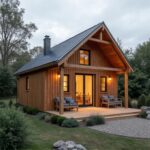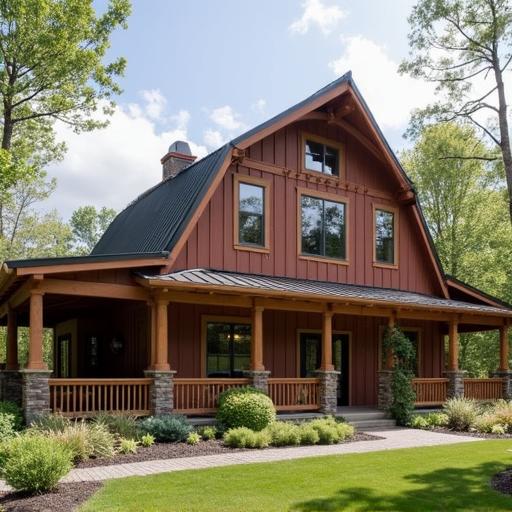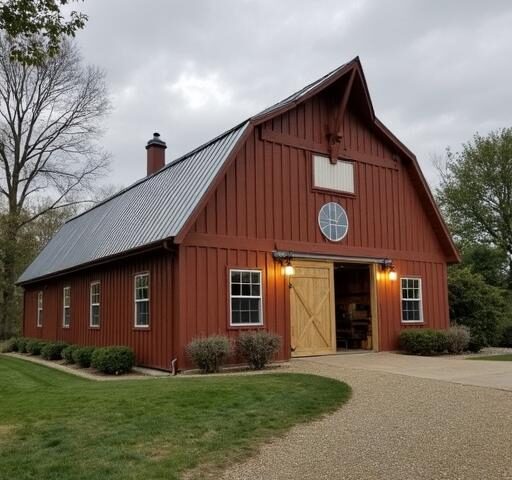
One Story Barndominiums: Discover Your Dream Home Today
July 22, 2025
Small Barndominium Kits: Unlock Your Dream Home Today
July 23, 2025Barndominium prices are attracting attention as more people consider this modern housing trend that merges the functionality of barns with the comforts of a home. A barndominium is essentially a building that combines living space and workspace, typically built from metal or wood.
This unique style is rapidly gaining popularity due to its versatility, affordability, and aesthetic appeal, making it an attractive choice for many prospective homeowners. With characteristics that allow for open floor plans and customization, barndominiums stand out in today’s housing market.
The key features that distinguish barndominiums from traditional homes include their spacious interiors and durability. Unlike conventional homes often designed to maximize square footage while conforming to standard layouts, barndominiums offer expansive open spaces ideal for various purposes-whether as family living areas or hobby spaces like workshops or art studios. Additionally, their rustic charm can seamlessly fit into rural settings while also appealing to those in suburban or even urban areas seeking a unique dwelling option.
As the trend continues to rise, understanding the factors influencing barndominium prices becomes essential for potential buyers. From location and materials used to specific design choices, each aspect plays a crucial role in determining overall costs. As you delve deeper into the world of barndominiums, you’ll discover not only how these savings can be realized but also why they present an increasingly viable alternative to traditional residential construction.
Understanding Barndominium Prices
Factors Influencing Barndominium Prices
When it comes to understanding barndominium prices, several key factors come into play. The initial cost of construction is often dictated by the location of the build. For instance, building in a rural area may lead to lower land costs compared to urban settings where real estate is at a premium. Additionally, availability of local resources can impact pricing; if certain materials are sourced locally, this can reduce transport expenses and thus lower overall costs.
Another significant contributor to barndominium pricing is the choice of materials and structural designs. Unlike traditional homes that may rely on wood framing and drywall, barndominiums often use steel frames with metal siding or other durable materials that can vary widely in price based on quality and brand. Homeowners seeking a more rustic appearance might opt for higher-quality finishes, such as reclaimed wood accents or custom wrought iron features, which would further influence the total cost.
Design choices also have a direct impact on barndominium prices. The layout-whether an open concept or segmented rooms-affects material costs as well as labor expenses during construction. Often, homeowners must also consider additional functionalities like loft areas or large garages that significantly increase square footage and require enhanced engineering considerations. Each decision influences both the aesthetic value and financial implications of their barndominium project.
The Role of Location in Pricing
Location not only plays a crucial role in establishing land costs but also affects aspects such as local permitting regulations and building codes. In regions where zoning laws are lenient toward unconventional structures like barndominiums, potential owners might find more cost-effective options for obtaining necessary permits than in areas where stricter regulations govern residential buildings. Moreover, proximity to necessary infrastructure-such as water lines and electricity-can alter initial installation costs.
Moreover, some locations may pose challenges such as extreme weather conditions which could necessitate specialized building techniques or stronger materials to ensure durability against environmental elements. Regions prone to hurricanes might compel homeowners to invest extra funds into reinforced structures or hurricane shutters while those in flood-prone zones may need elevated foundations leading to increased landscaping and engineering requirements.
While choosing a picturesque locale for your new barndominium can add charm, it’s essential for prospective buyers to weigh these varied factors carefully when assessing overall barndominium prices against their budgetary constraints and long-term investment goals.
Material Choices That Affect Costs
The selection of building materials greatly impacts both aesthetic appeal and financial investment in constructing a barndominium. Homeowners have numerous options ranging from standard steel exteriors to high-end finishes like cedar siding or stonework which can substantially inflate costs depending on personal taste preferences and available budgets.
Eco-friendly options have gained traction among modern builders trending towards sustainability without compromising design aesthetics. While alternative building techniques using recycled materials can sometimes yield savings over standard practices, they may still represent upfront investments that need consideration regarding long-term savings versus immediate expenses.
Furthermore, interior finishings-from flooring types like hardwood vs. laminate to fixtures used within kitchens and bathrooms-introduce another layer of complexity affecting final pricing as each decision cascades into larger spending as described previously with layout changes influencing material quantities required during construction phases.
Comparative Analysis
When examining barndominium prices in relation to traditional home construction, it’s essential to consider the fundamental differences in their design and building processes. A barndominium generally integrates living space with a workshop or garage, often resulting in less square footage allocated solely for livable areas compared to a conventional home. This flexible layout can lead to overall savings, both in initial investment and ongoing maintenance costs.
To better understand these distinctions, here’s a breakdown of key cost components:
- Base Construction Costs: Barndominiums typically benefit from lower base construction costs due to the use of metal framing and insulation techniques that are less expensive than traditional wood framing.
- Land and Site Preparation: While both housing types require land purchase, barndominiums can sometimes be built on less expensive parcels due to their adaptable nature and ability to use rural land effectively.
- Interior Customization: Traditional homes often involve more intricate renovations and high-end finishes that may not be as necessary in barndominiums, where interior spaces can remain more open and functional without compromising style.
In summary, when compared side-by-side with traditional homes, barndominiums frequently emerge as a more cost-effective solution for those looking at long-term value over immediate aesthetics. The flexibility in design choices allowed by barndominiums opens up opportunities for customization that can significantly impact overall spending without sacrificing quality or comfort. For prospective homeowners, diving deeper into these comparative aspects will ensure they make informed decisions regarding their investment in either building type.
Cost Breakdown of Barndominium Construction
Essential Components of Barndominium Construction Costs
When planning to build a barndominium, understanding the cost breakdown is vital for maintaining a realistic budget. The overall expenditure can vary significantly based on several key components, including land acquisition, construction materials, and labor expenses. Land costs will depend on the location chosen; rural areas tend to offer more affordable plots compared to urban settings where prices can skyrocket. Future homeowners should also factor in site preparation, which can include grading, drainage solutions, and utility access.
The choice of materials plays a crucial role in determining barndominium prices. Standard options like metal siding or roofing can provide durability without incurring hefty fees; however, those looking for aesthetic appeal might opt for wood finishes or various insulation methods that could increase costs.
Inside the barndominium, decisions regarding flooring types-whether it’s laminate, tile, or polished concrete-further influence the total investment. As each element accumulates, prospective owners must remain mindful of how these selections impact both functionality and financial output.
Additional Costs to Consider
Beyond the fundamental aspects of land and materials lie several additional costs that can affect the total budget for constructing a barndominium. Permits and inspections are often required by local governments before construction begins; these vary widely depending on regional regulations but can account for a significant sum if not accounted for beforehand. Furthermore, potential utility connections-including water supply and sewage systems-often carry fees that may be overlooked in initial budgeting plans.
Customizations also present an opportunity (and sometimes challenge) when it comes to managing costs while adding personal flair to a barndominium project. While an open floor plan may seem cost-effective at first glance, adding specialized features such as exposed beams or unique architectural elements will certainly raise expenses. It’s essential to balance personalized touches with practicality; researching cost-effective alternatives or even sourcing reclaimed materials could lead to significant savings without losing individual style.

Understanding Labor Costs
Labor is another major factor contributing to the overall barndominium construction price tag. Depending on your region’s average wage rates and skills available within the workforce, labor costs can fluctuate substantially. Hiring experienced contractors who specialize in barn-style constructions may warrant higher upfront expenses but could ultimately save money through efficiency during building phases and reducing errors that could arise from employing less experienced help.
Additionally, homeowners have the option of taking on some DIY projects themselves-such as interior finishing or landscaping-to trim down labor expenses significantly. However, it’s important to consider experience levels and time availability before opting for this route since mismanaged efforts could lead to increased long-term costs if professional repairs become necessary later down the line.
When all factors are considered holistically-from foundational works down through finishing touches-the true essence of what influences barndominium prices emerges clearer than ever.
Exploring Financing Options for Barndominiums
For those looking to invest in a barndominium, understanding the available financing options is crucial for effective budget management. Barndominiums tend to be more affordable than traditional homes, but securing the right financial backing can still present challenges. Many lenders are now recognizing the growing popularity of barndominiums and have tailored specific loan programs to meet the needs of prospective owners.
One common financing option for barndominium projects is through conventional loans, which are often backed by government-sponsored enterprises like Fannie Mae and Freddie Mac. These loans typically require a down payment ranging from 5% to 20%, depending on your creditworthiness and financial situation.
Another avenue worth exploring is USDA Rural Development loans that finance properties in designated rural areas, which may cover the cost of land plus construction without requiring a down payment-a feature that may greatly benefit prospective buyers looking for low – or no-down-payment options.
Additionally, several banks and credit unions have started offering construction loans specifically designed for non-traditional builds such as barndominiums. These loans usually cover only the cost of construction up until the home is complete, after which you transition into a mortgage payment structure. It’s important to shop around and consult multiple lenders in order to secure competitive interest rates and terms that suit your project timeline.
| Financing Option | Details |
|---|---|
| Conventional Loans | 5%-20% down payment required; backed by Fannie Mae/Freddie Mac. |
| USDA Rural Development Loans | No down payment; covers land & construction in rural areas. |
| Construction Loans | Covers costs until completion; transitions into traditional mortgage. |
With knowledge about these financing avenues at your disposal, you can approach your barndominium project with greater confidence. It’s vital to assess not just the immediate costs associated with building but also potential long-term implications of different loan structures on your financial health. Engaging with a financial advisor familiar with barndominium investments might also yield insights into personalized financing strategies that align with your specific circumstances.
Budgeting Tips for Building a Barndominium
When embarking on the journey of building a barndominium, effective budgeting is essential to ensuring that the final result aligns with your vision and financial capabilities. A thorough understanding of the various costs involved can help streamline the process and minimize unnecessary expenses. There are several key areas where potential owners should concentrate their budgeting efforts to make informed decisions.
First, start by determining a clear budget for land acquisition. Prices for land can vary significantly based on location, terrain, and proximity to urban centers. It’s crucial to conduct thorough research on real estate in your desired area. Additionally, considering properties that may need little site prep work can save substantial funds in excavation or preparation costs later on.
Next, focus on materials and labor-these will typically represent the largest portion of your barndominium prices. As you plan your build, create a detailed list that accounts for:
- Construction Materials: Choose cost-effective but durable materials for roofing, siding, insulation, and flooring.
- Labor Costs: Compare hiring contractors against DIY options to potentially lower expenses.
- Utilities Installation: Budget for the installation of plumbing, electrical systems, and HVAC services if they are not already in place.
To further optimize your budget without sacrificing quality or aesthetics, consider prioritizing simple design features and standard layouts over complex customizations. Streamlined designs often reduce both material waste and labor needed during construction.
By keeping these areas in check while planning your barndominium project, you’ll be on track toward an efficient building process that stays within budgetary constraints while delivering excellent value for money spent.
Design Choices That Affect Barndominium Prices
Design choices play a crucial role in determining barndominium prices, significantly impacting both the aesthetic appeal and functionality of these unique structures. As prospective homeowners delve into the world of barndominiums, they encounter a wide range of design elements that can enhance or detract from their project budget. Key features such as layout, exterior finishes, and interior spaces should be well thought out to ensure a balance between personal taste and cost efficiency.
The layout of the barndominium is one of the first considerations that influence price. Open floor plans may maximize space without incurring high costs associated with additional walls or rooms. However, custom layouts tailored to specific needs can lead to increased construction expenses.
For example, integrating distinct zones for living and working might require significant structural changes, which can elevate overall costs. Therefore, before finalizing a layout, it is essential for potential builders to evaluate their lifestyle needs against budget constraints while keeping in mind how these decisions will affect barndominium prices.
| Material Type | Average Cost Per Square Foot |
|---|---|
| Metal Siding | $8 – $12 |
| Wood Siding | $5 – $10 |
| Asphalt Shingles | $1 – $3 |
| Standing Seam Metal Roofs | $7 – $15 |
Interior design choices also represent significant opportunities for saving or spending. Simple finishes can keep costs manageable while personalized touches like custom cabinetry or high-end appliances tend to escalate prices quickly.
Thoughtful planning is imperative; for instance, opting for laminate countertops instead of granite could provide substantial savings without sacrificing quality too dramatically in terms of aesthetics. Balancing personal preferences with functional design will help homeowners maintain control over barndominium prices throughout their building journey while achieving a space they love to call home.
Conclusion
In conclusion, investing in a barndominium represents an innovative approach to modern living that combines the charm of rural aesthetics with the functionality of contemporary design. As we explored throughout this article, the rising popularity of barndominiums can be attributed to their unique features and remarkable cost-effectiveness when stacked against traditional home construction.
With their versatile layouts and open spaces, barndominiums not only cater to those who appreciate rustic beauty but also appeal to individuals seeking practical and affordable housing solutions.
Understanding barndominium prices is crucial for potential homeowners looking to embark on this exciting journey. Factors such as location, materials used, and specific design choices significantly affect overall costs. By conducting thorough research and careful planning-such as budgeting effectively for construction costs while exploring financing options-homeowners can make informed decisions that align with both their dream homes and financial realities. Moreover, smart design choices can lead to significant savings without sacrificing quality or artistic expression.
Ultimately, the choice to invest in a barndominium is more than just a financial decision; it’s an opportunity to create a personalized sanctuary that reflects one’s lifestyle and values. With increasing flexibility in design and pricing structures, now is the perfect time for prospective buyers to explore this stylish yet economical option.
Embracing barndominium living not only positions homeowners at the forefront of architectural trends but also allows them access to amazing value today within an evolving real estate landscape.




